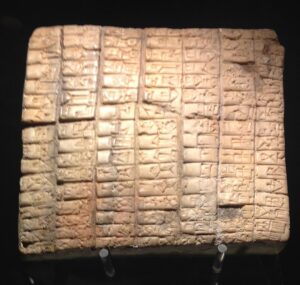
Ebla Tablet. By Davide Mauro – Own work, CC BY-SA 4.0, https://commons.wikimedia.org/w/index.php?curid=57338393
With all the twists and turns, the claims and denials, the arguments and the counter-arguments, is there anything we can be certain about in the Ebla story?
Virtually everyone agrees that the cache of cuneiform tablets uncovered at Tell Mardikh in northern Syria is a spectacular find that will radically alter our understanding of the history of the Near East in the third millennium B.C.
There is also no question that Tell Mardikh is to be identified as ancient Ebla. Although, even before the excavations at Tell Mardikh, Ebla was known from literary references to be an important center, its location was uncertain. That Tell Mardikh turned out to be Ebla came as a surprise because scholars previously thought that this area of Syria was a cultural backwater without a major urban center. The excavations at Tell Mardikh have revealed a large city that was apparently the capital of a vast empire which rivalled the civilizations of Mesopotamia to the east.
Exactly when did this Eblaite civilization exist?
We don’t know exactly. There is a dispute over about 200 years.
Read the rest of Ebla Update in the online Biblical Archaeology Society Library.